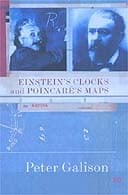Einstein's Clocks, Poincaré's Maps: Empires of Time
by Peter Galison
389pp, Sceptre, £16.99
Isaac Newton gave the Enlightenment a clockwork universe, which kept absolute time. But everyday time was different, simply the result of using one clock to set another. As a global system of commerce and exchange tightened its grip in the 19th century, one intellectual question with a practical aspect became crucial: could universal and human time ever be reconciled?
The modern answer, the one which holds in Einstein's universe, went beyond a simple "no" to render the question meaningless. In the cosmos described by special relativity, Einstein's first great theoretical step, there is no absolute time, no master reference frame. Time flows at different rates for different systems, depending on their relative motion. Simultaneity, and synchronisation, are matters of convention, established by closely defined measurements. There is no ultimate arbiter, no godly timekeeper in the machine - only a billion clocks ticking away, and corrected to agree with whichever one we decide to make the standard time- piece.
Today, when my bedroom alarm clock switches in and out of summer time in response to a radio signal, this seems easy to accept. Peter Galison's richly textured narrative evokes a period when it touched on controversies at the heart of physical science, even raising questions about what it meant to be scientific.
If some histories of science go for the grand narrative, this one turns on a single moment. The switch from classical physics, with its absolute time and space, and a cosmos filled with an immaterial ether, to a relativistic universe in which electromagnetic waves don't need anything to wave with , was as radical an intellectual move as any in the history of thought. Yet as Galison shows, seeing it only in that way, while a fair measure of its importance, is a poor framework for understanding what actually happened.
He goes deep into the practical and technological work of Einstein and his older contemporary Henri Poincaré, two great scientists "infinitely close and yet infinitely distant". Each in their different ways was intimately involved with the great practical questions of the day. Poincaré, a great physicist and mathematician, was also a promoter of world-spanning projects to rationalise time.
The young Einstein, often portayed as detached from his work in the Swiss patent office, was in fact fascinated by the design and construction of the innumerable devices for establishing and reproducing measured time which he had to assess. Both, as Galison puts it, lived at a time when it made sense to mingle machines and metaphysics.
In our terms, this was a crucial phase of the history of globalisation. Railway tracks were followed by telegraph lines. Telegraphs, and transatlantic cables, gave a better fix on longitude by transmitting accurate time signals. And that led to more accurate maps for the next round of railway building. A whole complex of new intellectual and physical links bound together a civilisation which was soon to fight a war by railway timetable.
Behind all these developments lay the problem of simultaneity. And it lay at the heart of Poincaré's and Einstein's physics. The Frenchman famously anticipated Einstein and dispensed with absolute time, defining simultaneity as achieved by co-ordinating clocks by exchange of electromagnetic signals. But although this depended on knowing the transit time of the signal, and hence raised the crucial questions about the speed of light and how it was propagated, he stopped one step short of the fully relativistic physics which Einstein conceived.
Galison's meticulously detailed reconstruction gives a satisfyingly complete account of the two men's differences. This is perhaps the most sophisticated history of science ever attempted in a popular science book. It is not exactly a racy read, but a wonderfully knowledgeable and thoughtful portrait of what really mattered in the forging of the a key aspect of the modern world.
· Jon Turney teaches science communication at University College London
